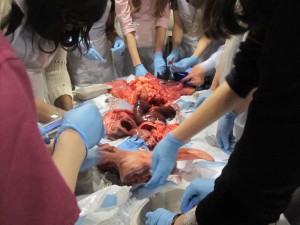
By Helen King
Finally, I understand what it is about dissection…
Regular readers will know that, among other things, I’m a visiting professor at a medical school. As a recently-founded medical school, this one does not teach through human dissection. Instead, students learn their anatomy through books, computer simulations, models, and ‘surface anatomy’. The rationale is not just about the difficulty of getting enough cadavers coupled with the recent availability of good online materials, but also about the purpose of training; many of these students will go into general practice after qualifying, and here the ability to understand what patients are feeling – to sympathize and to empathize – will be more important to them. Those who want to specialize in obstetrics, anaesthesia, surgery and so on will in any case be doing further training in which dissection will play a part.
Every year, my fourth-year students present to their fellow students on what they have learned in their Special Study Unit. Mine learn the history of dissection; the roles it has played in education, the objections made to it over time by the public and also by medical practitioners. For example, is studying a dead body the best way to prepare someone to study a living one? Does dissection ‘coarsen’ the mind, and reduce the physician’s ability to engage emotionally? Or is this all about gaining some sense of professional distance? But is that distance really such a good thing?
As part of their assessment, the students write a reflective journal. This is mine! This year, at the end of their excellent presentation of summaries of five periods of medical history, the students had a surprise for their peers: a dissection. Not, of course, a human one. They had bought a pig, or at least the non-edible parts which could be acquired cheaply, supplemented by the contents of the freezer of one of the students. Gloves, plastic aprons and scalpels were issued, the sharps disposal box put on the table, and the students in the audience were invited to get started.
The ensuing scene recalled many of the periods of medical history we’d studied. First, having a pig reminded us of Galen’s famous second-century AD vivisection, in which he showed how a pig’s squeal is generated – and stopped. The presence of pig organs raised many questions for the students about how far human and animal are comparable; questions that go back at least to Aristotle, that great comparative dissector of animals, in the fourth century BC. Then, the sheer enthusiasm of the students to be close to the dissection, to get involved, recalled the notes taken by a student present at Vesalius’ dissections back in 1540; he talked about them becoming positively over-excited, jostling each other for space, pushing so much that they couldn’t feel the beating heart that he invited them to touch. And finally, the enthusiasm with which our students brought out their phone-cameras, and took pictures of each other with the pig’s head, made us think of the late-nineteenth and early-twentieth century medical students who had themselves photographed with ‘their’ med school cadaver, and then sent the pictures to their family and friends.
The transgressive nature of dissection, the difficulty of seeing properly when it is basically quite messy, the bonding effect of working together – as a result of what my students did this year, I feel I have probably learned as much as they did!
